To begin, let me say something about the first word in the title of this essay: “conjure.” The verb “to conjure” is a complex one, for it includes in its standard definition a great range of possible actions or operations, not all of them equivalent, or even compatible. In its most common usage, “to conjure” means to perform an act of magic or to invoke a supernatural force, by casting a spell, say, or performing a particular ritual or rite. But “to conjure” is also to influence, to beg, to command or constrain, to charm, to bewitch, to move or convey, to imagine, to visualize, to call to mind, or to remember. “Conjure” was used in English as early as the 14th century; it derived from the Latin “conjurare,” meaning to band together through an oath or conspire.1 As such, “to conjure” bears a significant, resonant weight, one constituted by its tangle of meanings as well as by its long passage across continents and through history. For the 20th-century American artist Romare Bearden, the term “conjure” had a very specific meaning. The shape of that meaning is the subject of this essay.
Born in 1911 in Charlotte, North Carolina, Bearden moved with his family to New York City in 1914, settling in Harlem by 1920. As a child and young man, Bearden attended public school in New York, but also spent long stretches of time with relatives in Pittsburgh, PA, Mecklenburg County, NC, and Lutherville, MD. As a young adult in the 1930s and, after that, in the 1940s and 50s, Bearden juggled college; work as a cartoonist and illustrator; a job with New York’s Department of Social Services; art classes; a stint in the army; solo and group exhibitions at various New York galleries; study in Paris at the Sorbonne; travel in Italy and Spain; contact with prominent artists and philosophers, including Joan Miró, Pablo Picasso, Gaston Bachelard, and Hannah Arendt; commercial song-writing; and marriage. In 1959, he and his wife, Nanette, whom he had wed in 1954, moved into a loft on Canal Street, in Manhattan, where Bearden would reside for the rest of his life.2
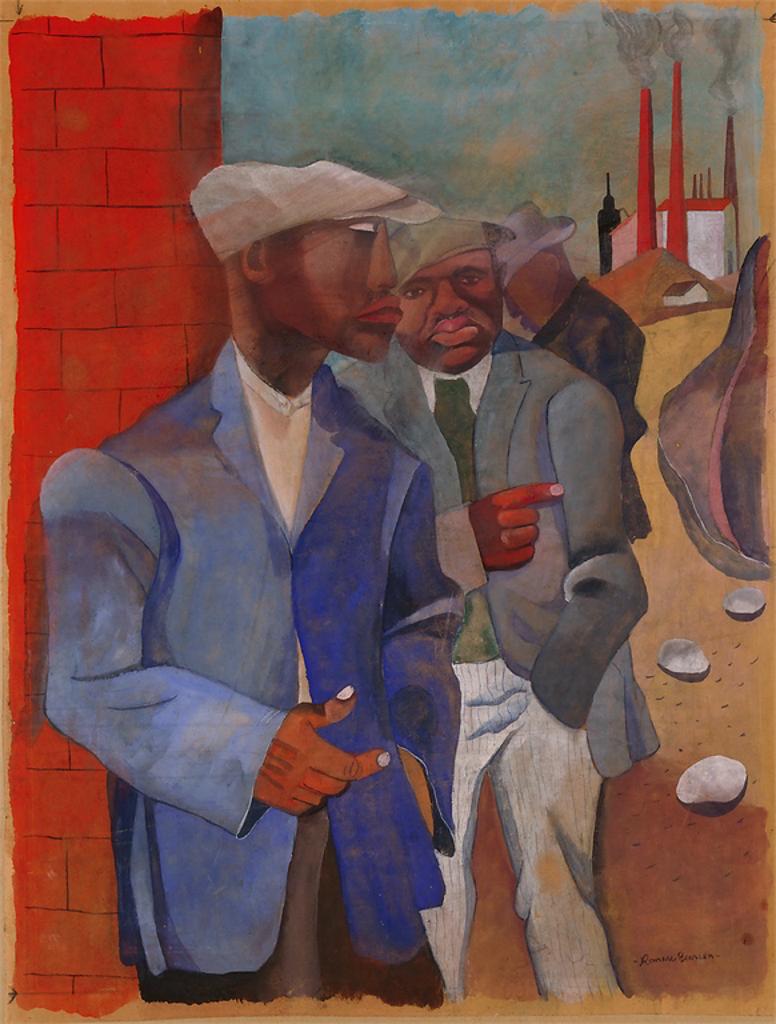
During this time, Bearden’s work for the most part alternated between social realist imagery—straightforward, unstinting depictions of everyday people, especially the working class, including his Factory Workers, from 1942, which was chosen to illustrate an article in Fortune Magazine entitled “The Negro’s War”—and experimental, quasi-abstract pictures, often with biblical or mythical subjects, as with The Payment of Judas (1945-46).3 Through the 1950s, Bearden’s primary medium was paint—oil, acrylic, watercolor, or gouache—but in the late 1950s and early 1960s he began to experiment with collage, pasting paper onto canvas to create figurative or abstract compositions; he also turned out a small number of completely non-objective works.4
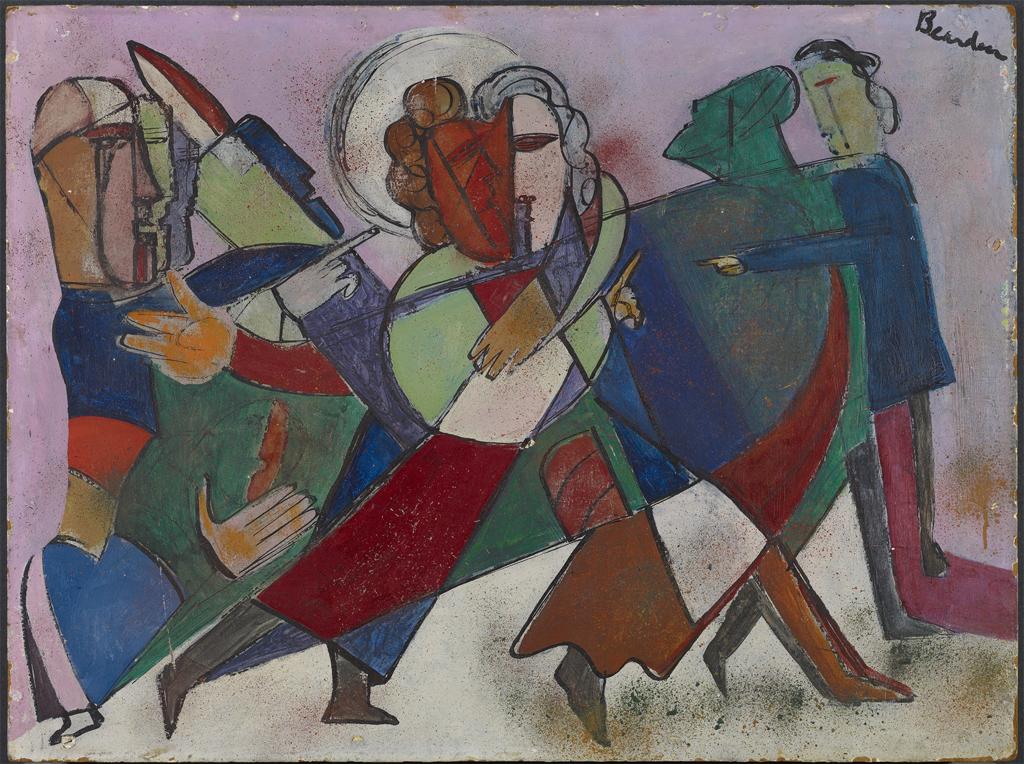
It was not until 1963, when he was in his early 50s, that Bearden turned his full attention to the medium of collage and, also, to the medium of photomontage, a technique in which a picture is created by combining cut-out parts of photographs. It was at this moment that he began producing the works for which he is now best known, including The Dove (1964), a collage made out of cut and pasted paper affixed to board and elaborated with gouache and pencil.
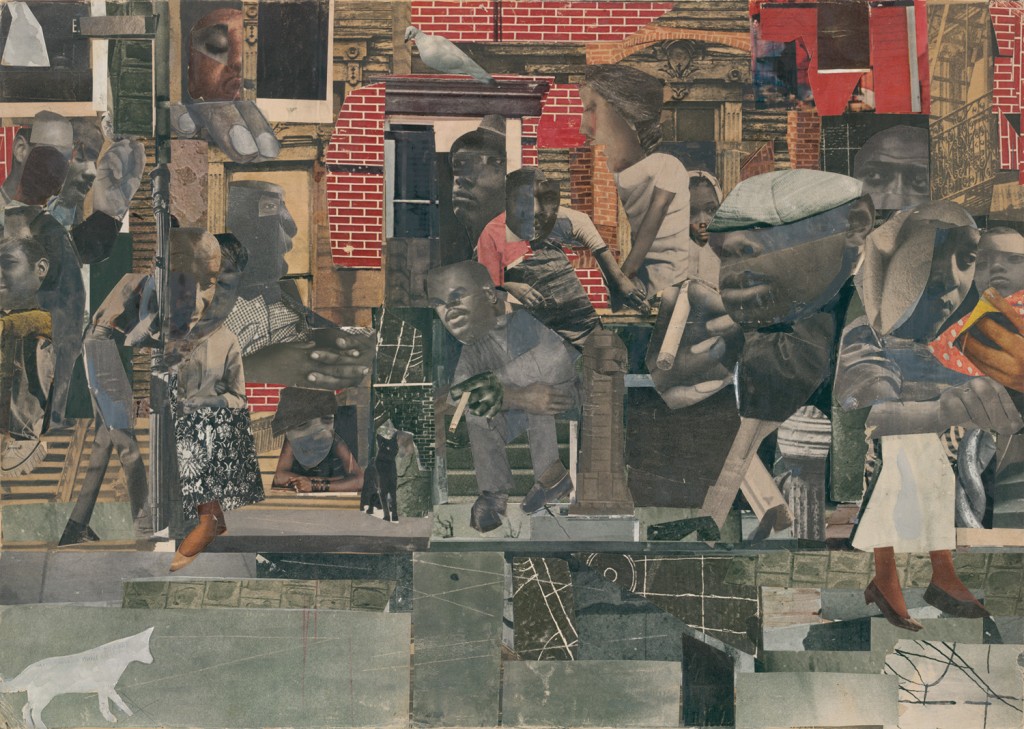
In The Dove, Bearden presents the scene on a New York street, the sidewalk thick with people strolling, talking, leaning, looking out of windows, and sitting on stoops. The picture registers almost immediately as a snapshot of the noisy, thick hustle of urban life and it does so despite the fact that it is, as a picture, a very strange one. Scraps of paper, cut-out photographs, and touches of paint and pencil form the bodies, buildings, and objects that we see. Bits of imagery from widely disparate sources—newspapers, magazines, product labels, construction paper, black and white or color photographs, wallpaper samples, architectural drawings—combine to create not a set of coherent forms but a series of disjointed and bizarrely scaled objects and bodies that lurch and stutter down the street as would a marionette puppet across a stage if operated by someone still learning the ropes. In the right half of the picture, a man whose head is far too large for his body, his eyes blocked or lopped off by a scrap of paper representing a cap, leans against a fire hydrant as a massive hand proffers an even more massive cigarette. Behind him stands a woman who holds in one oversize hand a piece of red and yellow fabric bearing a child’s head and in another a length of twisted, rope-like metal; the tumult of her barely cohering body is exacerbated by the shifting and irregular patchwork quilt of colors and patterns on which she walks. To the left of the eyeless man a cluster of five figures—a child, a woman, and three men—unfold in space, accordian-like, such that they seem to expand and contract in size, ballooning or shrinking, but not at all consistently or according to the rules of proportion or scale, so that it feels as if one sees them simultaneously from close up and far away. Their body parts spill and tumble across the small space that they occupy, seeming to come together as human wholes only by chance. A similar effect governs the left half of the picture, occupied by at least eight different figures, and here it can be even more difficult to tell which leg, arm, head, finger, or eye belongs to whom. Vivid reds, yellows, blues, and browns punctuate Bearden’s view of this New York street, which is otherwise a near-colorless mélange of washed out grays and blacks, creating a vibrant, rhythmic march from one side to the other that further disrupts the stability of the scene, sending its contents spinning and making it near impossible for the eyes to slow down and settle on a particular part, pin-balling as they do from one thing to the next.
Contributing to the strangeness of the scene, despite its whirl and tumult and its effects of fragmentation and dislocation, and also despite its visual appeal—the fact that one just does not want to stop looking because Bearden offers such a fascinating and perplexing set of sights to see—is the picture’s seamlessness, even slickness. To make his collages, Bearden began with a small board to which he added his cut paper and photographs as well as his paint and pencil marks; he then applied a resin emulsion adhesive to the whole and pressed the pieces to the board with a roller such that they settled into the viscous and thick adhesive and lay flat and still. While the adhesive dried, Bearden weighted the boards so that they would not warp.5 Such a technique, in The Dove and in Bearden’s other collages, creates the effect of a heavy varnish laid down over a painting’s surface; despite the variation among the collage’s many parts, the individual pieces can seem, at a material level, and against all odds, to be cut from the same cloth, their differences in texture and depth smoothed out and suppressed by the unifying, even petrifying resin. That such a smooth, fluid surface gives rise to such exuberant cacophony is part of what I would call the strange magic, and also the strange pleasure, of Bearden’s collages.6
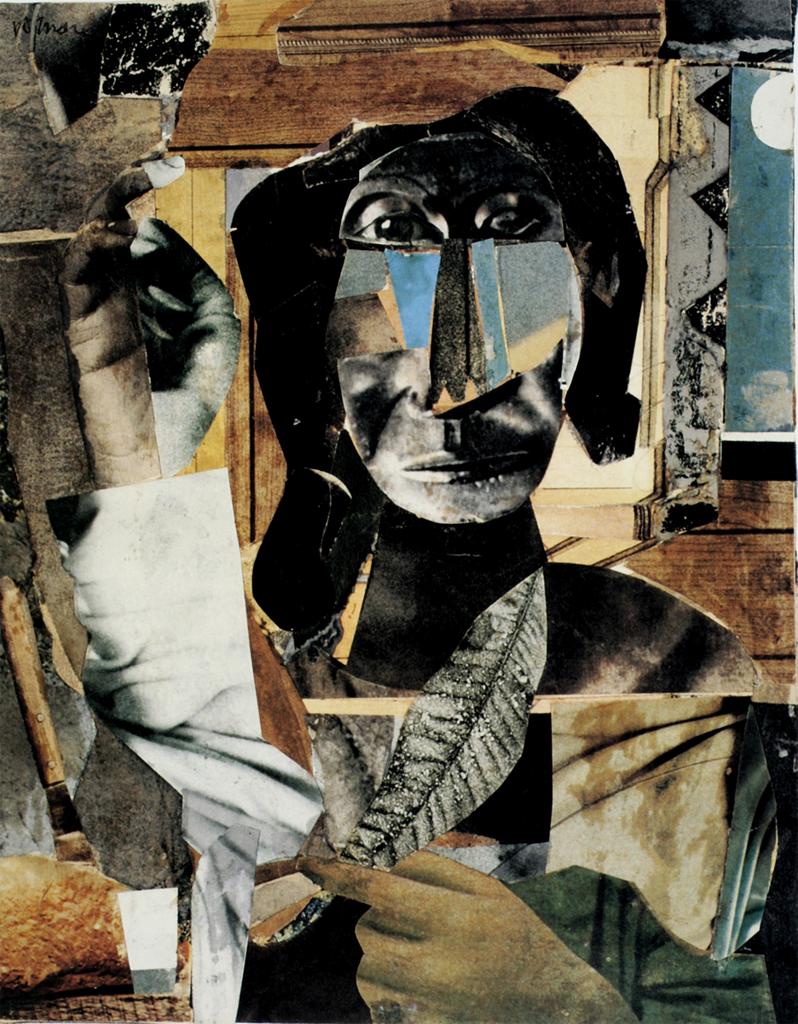
Almost all of the collages from this period boast similar effects. Their subject matter, as with The Dove, is also typical: scenes from everyday life in the African-American communities of New York, Pittsburgh, Charlotte, and other of Bearden’s haunts, and Bearden’s own memories of these places and their people growing up: sitting down to a meal or a game of cards, watching trains pull in and out of the yard, listening to music on a Saturday night. Typical in style and subject, also, are works such as The Prevalence of Ritual: Conjur Woman (1964) and Conjur Woman (1971). Both feature a “Conjur Woman” (“conjur” without an “e,” as Bearden spells it), and thus bring us back to that wide-ranging and slippery verb I discussed above, “to conjure.” Bearden’s turn to collage in 1963 was accompanied by the appearance of the character of the conjure woman in his work; the frequency with which he depicted or evoked her in the mid-1960s and beyond suggests her special significance within his artistic practice and, also, I would argue, a special relationship between her and the very medium of collage. “A conjur woman,” wrote Bearden in 1969, “was an important figure in a number of Southern Negro rural communities. She was called on to prepare love potions; to provide herbs to cure various illnesses; and to be consulted regarding vexing personal and family problems. Much of her knowledge had been passed on through the generations from an African past, although a great deal was learned from the American Indians. A conjur woman was greatly feared and it was believed that she could change her appearance.”7 With roots in African tradition and wisdom, then, the conjur woman was an important part of many African-American communities, in the Southern United States and also in the North, where the tradition had migrated along with its practitioners and believers: important as an actual, physical presence—someone whom a person could hire to cast a spell or cure an ailment—or important simply, but not insignificantly, as an idea, metaphor, or myth.8
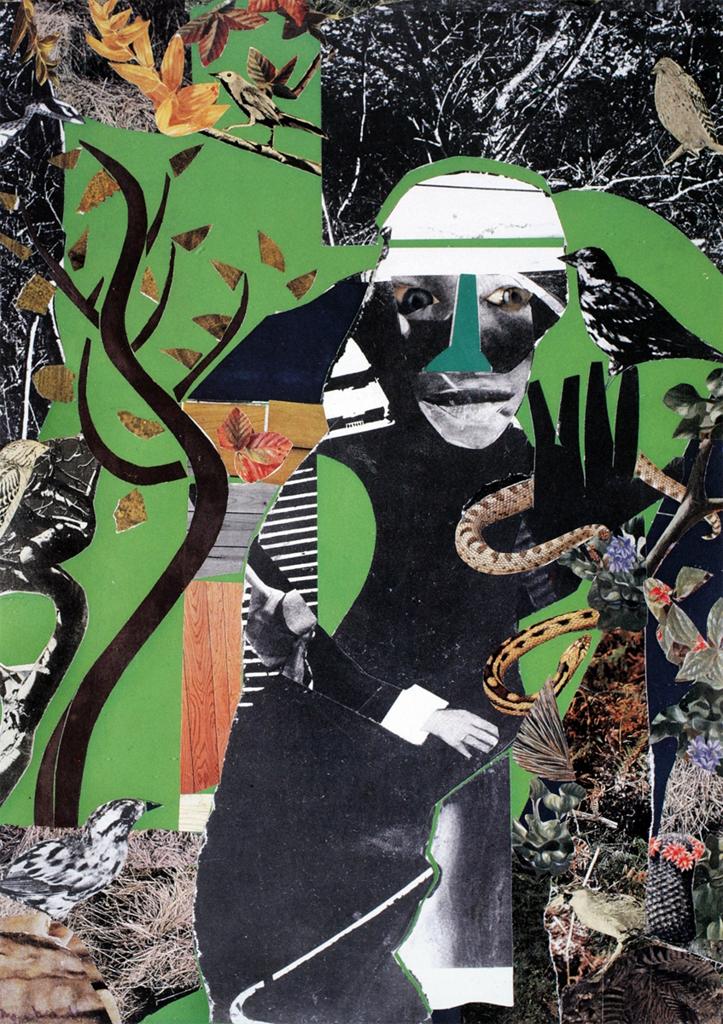
Scholars tend to agree that the conjur woman, as with train yards, evening card games, and weekend music-listening, was for Bearden a subject close to home, an autobiographical evocation of the community to which he belonged and the characters, beliefs, and traditions that were a fundamental part of his life growing up in the South and in New York’s Harlem. Scholars also have suggested that Bearden’s conjur women called forth for him an alternate sphere, a rich and redolent zone of magic and the supernatural adjacent to but distinct from the everyday, what constituted a world apart from the prejudice, racism, and segregation regularly faced by African Americans in their normal existence, one that looked back to and drew on traditional African or African American culture for strength and solidarity as well as a way forward in the now.9 Indeed, there can be no doubt that these works are about self, tradition, and race. How could they not be, given who made them—Bearden, an African American deeply invested in the politics of equality, an artist and activist both—and, also, given what they depict?
But what I want to suggest is that there is more to the story than this, and the “more” I wish to evoke has everything to do with what I characterized as a special relationship between conjure and the medium of collage in Bearden’s practice. I have always been struck by the fact that Bearden turned to collage in the 1960s, at a moment well past the hey-day of the medium. Collage was for artists like Pablo Picasso and George Braque in the early years of the 20th century a means by which to engineer a radical transformation of painting and the pictorial surface, and collage along with photomontage offered a vehicle of social critique for artists of the European avant-garde during the interwar period, the cutting, slicing, fragmenting, and reconstituting involved in making a collage or photomontage providing apt metaphors for the trauma and violence of war and political oppression, the evisceration of the status quo, and the piecing together of new societal forms.10 But what, decades later, was collage for Bearden? What bite could it possibly have well after the fact of its initial radicalness, when it was old news instead of new?
As it happens, Bearden turned to making collages almost by default. In 1963, a few months before Martin Luther King’s historic march on Washington, he began meeting regularly with other socially- and politically-minded artists, all of them African American. They gathered in Bearden’s Canal Street studio and called their cohort “Spiral,” a term that was meant to represent expanding positive energy. Meetings were held to discuss art and brainstorm exhibition opportunities, but above all the group wished to explore collaboratively the potential role for artists in the struggle for Civil Rights. At one such meeting, in 1963, Bearden suggested that the group collaborate on an art project, and he showed his colleagues a stack of clippings from newspapers and magazines that he hoped could be used in the collective creation of a collage, an activity he believed could model the kind of collective action the group wished to pursue in the political realm.11 The idea did not catch on, but this marks the point at which Bearden himself took up the project of collage and began making the works under discussion here. Bearden’s proposal of a collective action collage, and the fact that he carried forth the project on his own, makes clear that he understood the medium to have value beyond the artistic and also that he believed that as an object, a literal thing, collage might do powerful, transformative work.12
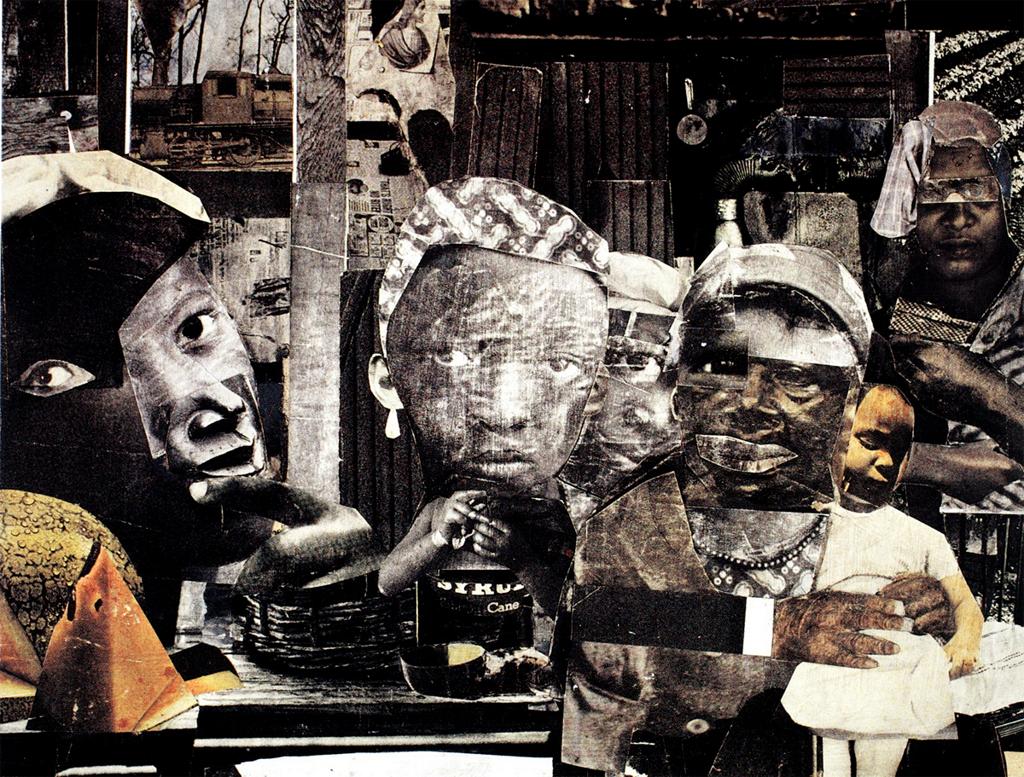
Put another way, Bearden wanted his collages to conjure. Of course, all representational images conjure in the sense that they gather together colors and shapes to form an image of the world and in so doing call to the minds of their viewers various ideas, emotions, associations, and memories. But in making the conjur woman so prevalent in his imagery and in adopting the medium of collage, which by its very nature extracts material from the world and then transmutes it, turning so many scraps of paper into a novel physical form, Bearden suggested that he had in mind for his art an instrumentality beyond the norm, a capacity, akin to that of the conjur woman, that exceeded human limits and approximated new ways of seeing and being. Bearden did not think he could make his pictures really, in a literal sense see or act—of course not—but in them he set about fashioning a model of what it might be like to see and know the world through other than human eyes, much as a conjure woman through ritual objects, herbal mixtures, incantations, and rites harnessed the supernatural to interrupt and transform the natural, human-bound course of things. Indeed, what one sees when looking at one of Bearden’s collages, including Prevalence of Ritual: Mysteries (1964), is not what the eyes would see, or could ever see, were one looking at the actual world, at least not quite. To be sure, the viewer, in point of fact, does look at the actual—the physical, material—world when looking one of these works, for the collages are made out of literal pieces of that world: they give that viewer the “real” in no uncertain terms. But those pieces, excerpted, rearranged, and shellacked flat to a board still seem to arise as if through a form of extra-human sight. One sees not as a human does, but as a camera lens might, zooming in and out as scale enlarges and contracts and objects balloon and shrink, or perhaps like an insect, the compound vision of which, enabled by clusters of hundreds, even thousands of visual receptors, produces not a single coherent view but a mosaic pattern of alternating lights and darks. The fact that the viewer recognizes what he or she sees as the literal real—actual artifacts from everyday life, newspaper clippings, photographs, and so forth, and the fact that one of Bearden’s resin-heavy, board-backed collages feels solid and weighty in the hand, as much brute object as it is image—makes how that viewer sees these things, in a manner unavailable to the unaided human eye and that renders null the physical, gravitational limits of the material world, feel all the more bizarre and unexplained, enchanted even. The kind of attention Bearden pays to eyes throughout his collages suggests just such an investment in new ways of seeing.13 In Mysteries, a female figure just to the right of center, the one who holds a child, boasts a face created from at least six different sources. One of her eyes, the one to our right, seems properly encased in her skull and skin; the other one, however, appears to hover above her face, the pasted square of paper thus calling to mind the grotesque enlargement and spatial displacement of the eye that occurs when a person looks through a magnifying glass, an optical effect that I take to be yet an other emblem of other-than-human sight. In this scenario, then, Bearden reiterates the supersight he bequeaths to his viewer by compelling that viewer to come face to face with another supersighted being, a seer, one with a giant, outsized eye that is echoed and rearticulated in the patched-on, cyborg-like eyes of the figures at the extreme right and left edges of the scene. In the photogravure and aquatint version of this work entitled The Train that Bearden made several years later, in 1975, the woman’s eye is again singled out, bursting emphatically as it does from a surrounding, receding wash of blue. The conjur women in Bearden’s collages, themselves, feature the eyes of animals or ritual masks, further underscoring the extra-human seeing Bearden seems to wish to call forth and incarnate in his collage works. And in The Dove, the only bodies that Bearden allows to be whole, not made up of multiple parts and thus fully in charge of their actions as well as their being, are those of animals: a cat (or is it a dog?) that watches over the street from the lower left, another cat seated at the base of the stoop, its eye shining bright against its black fur, and the dove (of the title) who surveys the scene from a perch above the door, and who calls to mind the traditional Christian symbol for the Holy Spirit. All three reinforce, as manifestly seeing animals, this call for extra-human perception.
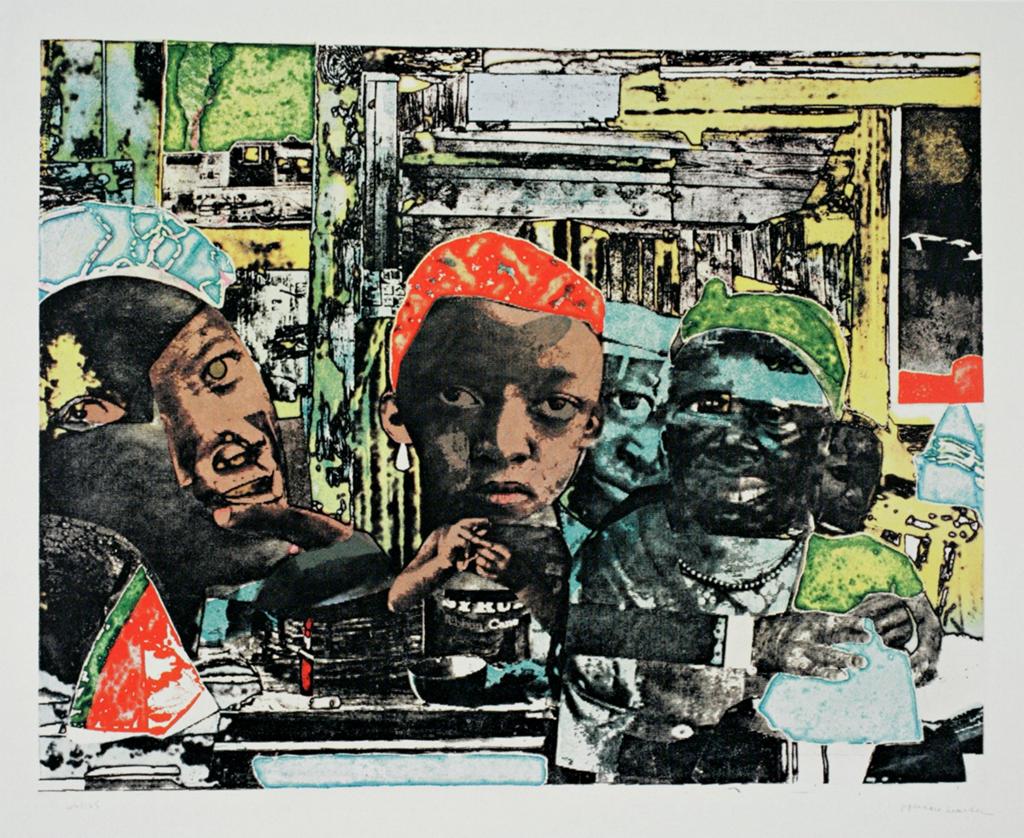
In another work, Prevalence of Ritual: Baptism (1964), which would become, along with Prevalence of Ritual: Conjur Woman and Prevalence of Ritual: Mysteries, part of a series, Bearden extracts and recombines animals, humans, and inanimate objects to create a mass of simultaneously monstrous and alluring bodies, the bulk of them waist-deep in water. Here, the rite of river baptism evokes Bearden’s childhood memories of the South but also serves as a metaphor for ritual transformation and reconstitution.14 It is tempting to imagine the dripping resin adhesive that Bearden poured over his clippings and cut-outs as akin to the water that pours over one’s head in a baptism ceremony, depicted here by a hand spouting water at the top of the scene. It is equally tempting to see the immersion of the paper scraps in the viscous adhesive of the collage as akin to bodies plunged into liquid for the purpose of ritual rebirth. It is as if Bearden, already bent on using the physical material of the world in his work, rather than just pictorial representations of this world, wished for his weighted-down, solid pictures to embody ritual practice by approximating the literal forms and properties of the materials and instruments used in a transformative, being-reconfiguring rite: collage as ritual or incantatory object, one might say.
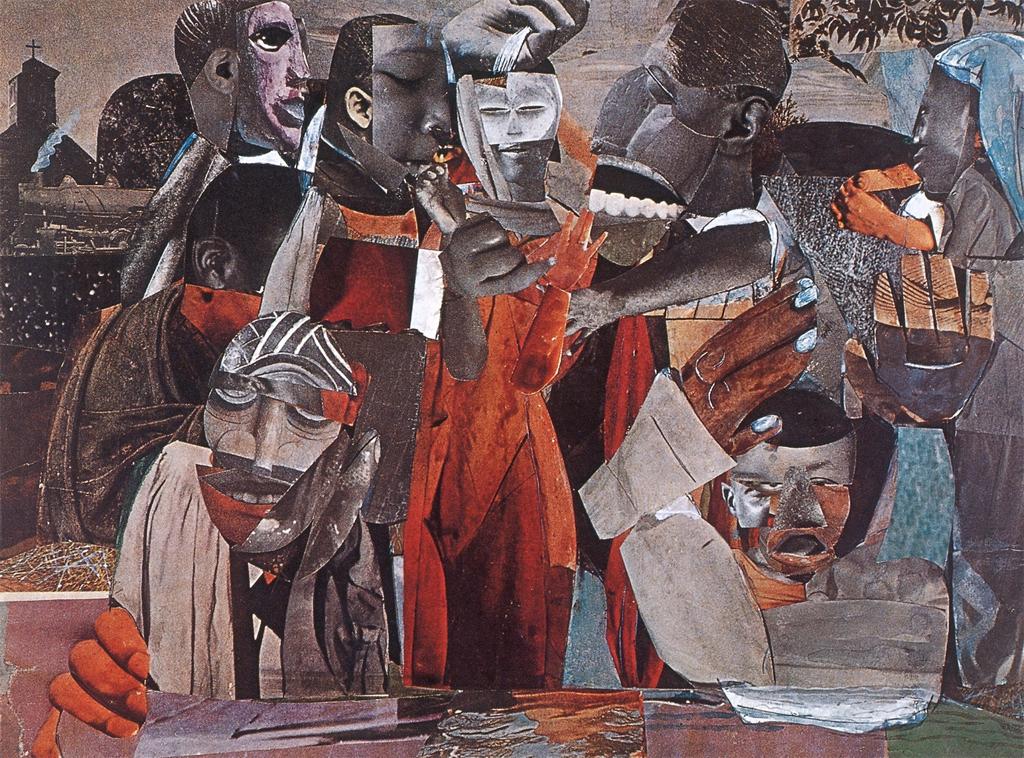
What is more, Bearden performed his own transformative ritual in the course of creating and deploying his collages, first by conjuring them from the everyday world and then by using them as instruments to conjure yet another form. Bearden created approximately two-dozen collages in the mid-sixties, including the ones I discuss here; all of these he converted into Photostats, which he called “Projections.” Produced by using an oversize camera loaded with rolls of photographic paper rather than film, a Photostat consists of an image produced directly from the original, either a negative or a positive image: in Bearden’s case, a positive one, and enlarged.15 In rendering his collages photostatically, taking the original form and calling forth from it something new, Bearden replaced his own eyes and hands with those of a machine—not to valorize or glorify machine production, but to, once again, suggest an extra-human mode of seeing and making, one analogous to the conjuring he so regularly depicted and that, through its many operations, from invocation and transformation to visualization and conveyance, embraced and instantiated the myriad meanings of the verb “to conjure.” As with photography, the Photostat technique used light, that “pencil of nature,” as the medium by which an image was generated, and it is not hard to imagine Bearden here as a kind of conjure figure, compelling the light to do his bidding so as to make a new thing arise from the old, as with the curing of an illness, the settling of a dispute, or the shape-shifting attributed to the conjure woman herself. The fact that Bearden chose a female figure to serve as his surrogate or avatar underscores his wish to signal the displacement of natural vision through the incarnation of a form of seeing that transcended the limits of human cognition and, also, the limits of human biology.16 It should be clear by now that Bearden would have had many reasons to wish for himself such powers: he was an ambitiously imaginative artist, but he was also deeply invested in changing the world. The group endeavor “Spiral” arose as much from political conviction as it did from artistic affinity and its one and only group show, held in 1965 in New York, took direct aim at the Museum of Modern Art, whose series of “Americans” exhibitions, initiated in 1929 and continuing into the 1960s, had as of 1965 not featured a single African American artist. The fact that Bearden’s contribution to the Spiral show was a Photostat enlargement of one of his collages, Conjur Woman (1964), underscores the links he made among conjuring, art-making, and transformative action in the political sphere.
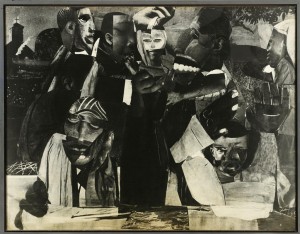
And what of “collapse,” the term that follows on the heels of “conjure” in my title? I will spare the reader the dictionary definition, not to worry. But I do intend something specific in using the term, for by collapse I do not mean failure or breakdown; rather, I want to evoke another sort of dismantling or giving way. Ralph Ellison’s Invisible Man (1952) opens with the following lines: “I am invisible, understand, simply because people refuse to see me. Like the bodiless heads you see sometimes in circus sideshows, it is as though I have been surrounded by mirrors of hard, distorting glass.…That invisibility to which I refer occurs because of a peculiar disposition of the eyes of those with whom I come in contact. A matter of the construction of their inner eyes, those eyes with which they look through their physical eyes upon reality.”17 In 1966, in response to a question from a journalist, Bearden declared that “Western society, and particularly that of America, is gravely ill and a major symptom is the American treatment of the Negro.”18 In a world where not just eyes, but the very mechanism of cognition—the inner perceptual apparatus by which humans come to know and to judge—was subject to dysfunction and the social body as a whole was stricken with disease, nothing but a literal collapse, a dismantling of old ways of seeing and knowing, and a piecing together of new modes of perception and being, would suffice. Such a collapse, to Bearden’s mind, was something art, and collage in particular, could help to conjure.
Notes
To begin, let me say something about the first word in the title of this essay: “conjure.” The verb “to conjure” is a complex one, for it includes in its standard definition a great range of possible actions or operations, not all of them equivalent, or even compatible. In its most common usage, “to conjure” means to perform an act of magic or to invoke a supernatural force, by casting a spell, say, or performing a particular ritual or rite. But “to conjure” is also to influence, to beg, to command or constrain, to charm, to bewitch, to move or convey, to imagine, to visualize, to call to mind, or to remember. “Conjure” was used in English as early as the 14th century; it derived from the Latin “conjurare,” meaning to band together through an oath or conspire.1 As such, “to conjure” bears a significant, resonant weight, one constituted by its tangle of meanings as well as by its long passage across continents and through history. For the 20th-century American artist Romare Bearden, the term “conjure” had a very specific meaning. The shape of that meaning is the subject of this essay.
Born in 1911 in Charlotte, North Carolina, Bearden moved with his family to New York City in 1914, settling in Harlem by 1920. As a child and young man, Bearden attended public school in New York, but also spent long stretches of time with relatives in Pittsburgh, PA, Mecklenburg County, NC, and Lutherville, MD. As a young adult in the 1930s and, after that, in the 1940s and 50s, Bearden juggled college; work as a cartoonist and illustrator; a job with New York’s Department of Social Services; art classes; a stint in the army; solo and group exhibitions at various New York galleries; study in Paris at the Sorbonne; travel in Italy and Spain; contact with prominent artists and philosophers, including Joan Miró, Pablo Picasso, Gaston Bachelard, and Hannah Arendt; commercial song-writing; and marriage. In 1959, he and his wife, Nanette, whom he had wed in 1954, moved into a loft on Canal Street, in Manhattan, where Bearden would reside for the rest of his life.2

During this time, Bearden’s work for the most part alternated between social realist imagery—straightforward, unstinting depictions of everyday people, especially the working class, including his Factory Workers, from 1942, which was chosen to illustrate an article in Fortune Magazine entitled “The Negro’s War”—and experimental, quasi-abstract pictures, often with biblical or mythical subjects, as with The Payment of Judas (1945-46).3 Through the 1950s, Bearden’s primary medium was paint—oil, acrylic, watercolor, or gouache—but in the late 1950s and early 1960s he began to experiment with collage, pasting paper onto canvas to create figurative or abstract compositions; he also turned out a small number of completely non-objective works.4

It was not until 1963, when he was in his early 50s, that Bearden turned his full attention to the medium of collage and, also, to the medium of photomontage, a technique in which a picture is created by combining cut-out parts of photographs. It was at this moment that he began producing the works for which he is now best known, including The Dove (1964), a collage made out of cut and pasted paper affixed to board and elaborated with gouache and pencil.

In The Dove, Bearden presents the scene on a New York street, the sidewalk thick with people strolling, talking, leaning, looking out of windows, and sitting on stoops. The picture registers almost immediately as a snapshot of the noisy, thick hustle of urban life and it does so despite the fact that it is, as a picture, a very strange one. Scraps of paper, cut-out photographs, and touches of paint and pencil form the bodies, buildings, and objects that we see. Bits of imagery from widely disparate sources—newspapers, magazines, product labels, construction paper, black and white or color photographs, wallpaper samples, architectural drawings—combine to create not a set of coherent forms but a series of disjointed and bizarrely scaled objects and bodies that lurch and stutter down the street as would a marionette puppet across a stage if operated by someone still learning the ropes. In the right half of the picture, a man whose head is far too large for his body, his eyes blocked or lopped off by a scrap of paper representing a cap, leans against a fire hydrant as a massive hand proffers an even more massive cigarette. Behind him stands a woman who holds in one oversize hand a piece of red and yellow fabric bearing a child’s head and in another a length of twisted, rope-like metal; the tumult of her barely cohering body is exacerbated by the shifting and irregular patchwork quilt of colors and patterns on which she walks. To the left of the eyeless man a cluster of five figures—a child, a woman, and three men—unfold in space, accordian-like, such that they seem to expand and contract in size, ballooning or shrinking, but not at all consistently or according to the rules of proportion or scale, so that it feels as if one sees them simultaneously from close up and far away. Their body parts spill and tumble across the small space that they occupy, seeming to come together as human wholes only by chance. A similar effect governs the left half of the picture, occupied by at least eight different figures, and here it can be even more difficult to tell which leg, arm, head, finger, or eye belongs to whom. Vivid reds, yellows, blues, and browns punctuate Bearden’s view of this New York street, which is otherwise a near-colorless mélange of washed out grays and blacks, creating a vibrant, rhythmic march from one side to the other that further disrupts the stability of the scene, sending its contents spinning and making it near impossible for the eyes to slow down and settle on a particular part, pin-balling as they do from one thing to the next.
Contributing to the strangeness of the scene, despite its whirl and tumult and its effects of fragmentation and dislocation, and also despite its visual appeal—the fact that one just does not want to stop looking because Bearden offers such a fascinating and perplexing set of sights to see—is the picture’s seamlessness, even slickness. To make his collages, Bearden began with a small board to which he added his cut paper and photographs as well as his paint and pencil marks; he then applied a resin emulsion adhesive to the whole and pressed the pieces to the board with a roller such that they settled into the viscous and thick adhesive and lay flat and still. While the adhesive dried, Bearden weighted the boards so that they would not warp.5 Such a technique, in The Dove and in Bearden’s other collages, creates the effect of a heavy varnish laid down over a painting’s surface; despite the variation among the collage’s many parts, the individual pieces can seem, at a material level, and against all odds, to be cut from the same cloth, their differences in texture and depth smoothed out and suppressed by the unifying, even petrifying resin. That such a smooth, fluid surface gives rise to such exuberant cacophony is part of what I would call the strange magic, and also the strange pleasure, of Bearden’s collages.6

Almost all of the collages from this period boast similar effects. Their subject matter, as with The Dove, is also typical: scenes from everyday life in the African-American communities of New York, Pittsburgh, Charlotte, and other of Bearden’s haunts, and Bearden’s own memories of these places and their people growing up: sitting down to a meal or a game of cards, watching trains pull in and out of the yard, listening to music on a Saturday night. Typical in style and subject, also, are works such as The Prevalence of Ritual: Conjur Woman (1964) and Conjur Woman (1971). Both feature a “Conjur Woman” (“conjur” without an “e,” as Bearden spells it), and thus bring us back to that wide-ranging and slippery verb I discussed above, “to conjure.” Bearden’s turn to collage in 1963 was accompanied by the appearance of the character of the conjure woman in his work; the frequency with which he depicted or evoked her in the mid-1960s and beyond suggests her special significance within his artistic practice and, also, I would argue, a special relationship between her and the very medium of collage. “A conjur woman,” wrote Bearden in 1969, “was an important figure in a number of Southern Negro rural communities. She was called on to prepare love potions; to provide herbs to cure various illnesses; and to be consulted regarding vexing personal and family problems. Much of her knowledge had been passed on through the generations from an African past, although a great deal was learned from the American Indians. A conjur woman was greatly feared and it was believed that she could change her appearance.”7 With roots in African tradition and wisdom, then, the conjur woman was an important part of many African-American communities, in the Southern United States and also in the North, where the tradition had migrated along with its practitioners and believers: important as an actual, physical presence—someone whom a person could hire to cast a spell or cure an ailment—or important simply, but not insignificantly, as an idea, metaphor, or myth.8

Scholars tend to agree that the conjur woman, as with train yards, evening card games, and weekend music-listening, was for Bearden a subject close to home, an autobiographical evocation of the community to which he belonged and the characters, beliefs, and traditions that were a fundamental part of his life growing up in the South and in New York’s Harlem. Scholars also have suggested that Bearden’s conjur women called forth for him an alternate sphere, a rich and redolent zone of magic and the supernatural adjacent to but distinct from the everyday, what constituted a world apart from the prejudice, racism, and segregation regularly faced by African Americans in their normal existence, one that looked back to and drew on traditional African or African American culture for strength and solidarity as well as a way forward in the now.9 Indeed, there can be no doubt that these works are about self, tradition, and race. How could they not be, given who made them—Bearden, an African American deeply invested in the politics of equality, an artist and activist both—and, also, given what they depict?
But what I want to suggest is that there is more to the story than this, and the “more” I wish to evoke has everything to do with what I characterized as a special relationship between conjure and the medium of collage in Bearden’s practice. I have always been struck by the fact that Bearden turned to collage in the 1960s, at a moment well past the hey-day of the medium. Collage was for artists like Pablo Picasso and George Braque in the early years of the 20th century a means by which to engineer a radical transformation of painting and the pictorial surface, and collage along with photomontage offered a vehicle of social critique for artists of the European avant-garde during the interwar period, the cutting, slicing, fragmenting, and reconstituting involved in making a collage or photomontage providing apt metaphors for the trauma and violence of war and political oppression, the evisceration of the status quo, and the piecing together of new societal forms.10 But what, decades later, was collage for Bearden? What bite could it possibly have well after the fact of its initial radicalness, when it was old news instead of new?
As it happens, Bearden turned to making collages almost by default. In 1963, a few months before Martin Luther King’s historic march on Washington, he began meeting regularly with other socially- and politically-minded artists, all of them African American. They gathered in Bearden’s Canal Street studio and called their cohort “Spiral,” a term that was meant to represent expanding positive energy. Meetings were held to discuss art and brainstorm exhibition opportunities, but above all the group wished to explore collaboratively the potential role for artists in the struggle for Civil Rights. At one such meeting, in 1963, Bearden suggested that the group collaborate on an art project, and he showed his colleagues a stack of clippings from newspapers and magazines that he hoped could be used in the collective creation of a collage, an activity he believed could model the kind of collective action the group wished to pursue in the political realm.11 The idea did not catch on, but this marks the point at which Bearden himself took up the project of collage and began making the works under discussion here. Bearden’s proposal of a collective action collage, and the fact that he carried forth the project on his own, makes clear that he understood the medium to have value beyond the artistic and also that he believed that as an object, a literal thing, collage might do powerful, transformative work.12

Put another way, Bearden wanted his collages to conjure. Of course, all representational images conjure in the sense that they gather together colors and shapes to form an image of the world and in so doing call to the minds of their viewers various ideas, emotions, associations, and memories. But in making the conjur woman so prevalent in his imagery and in adopting the medium of collage, which by its very nature extracts material from the world and then transmutes it, turning so many scraps of paper into a novel physical form, Bearden suggested that he had in mind for his art an instrumentality beyond the norm, a capacity, akin to that of the conjur woman, that exceeded human limits and approximated new ways of seeing and being. Bearden did not think he could make his pictures really, in a literal sense see or act—of course not—but in them he set about fashioning a model of what it might be like to see and know the world through other than human eyes, much as a conjure woman through ritual objects, herbal mixtures, incantations, and rites harnessed the supernatural to interrupt and transform the natural, human-bound course of things. Indeed, what one sees when looking at one of Bearden’s collages, including Prevalence of Ritual: Mysteries (1964), is not what the eyes would see, or could ever see, were one looking at the actual world, at least not quite. To be sure, the viewer, in point of fact, does look at the actual—the physical, material—world when looking one of these works, for the collages are made out of literal pieces of that world: they give that viewer the “real” in no uncertain terms. But those pieces, excerpted, rearranged, and shellacked flat to a board still seem to arise as if through a form of extra-human sight. One sees not as a human does, but as a camera lens might, zooming in and out as scale enlarges and contracts and objects balloon and shrink, or perhaps like an insect, the compound vision of which, enabled by clusters of hundreds, even thousands of visual receptors, produces not a single coherent view but a mosaic pattern of alternating lights and darks. The fact that the viewer recognizes what he or she sees as the literal real—actual artifacts from everyday life, newspaper clippings, photographs, and so forth, and the fact that one of Bearden’s resin-heavy, board-backed collages feels solid and weighty in the hand, as much brute object as it is image—makes how that viewer sees these things, in a manner unavailable to the unaided human eye and that renders null the physical, gravitational limits of the material world, feel all the more bizarre and unexplained, enchanted even. The kind of attention Bearden pays to eyes throughout his collages suggests just such an investment in new ways of seeing.13 In Mysteries, a female figure just to the right of center, the one who holds a child, boasts a face created from at least six different sources. One of her eyes, the one to our right, seems properly encased in her skull and skin; the other one, however, appears to hover above her face, the pasted square of paper thus calling to mind the grotesque enlargement and spatial displacement of the eye that occurs when a person looks through a magnifying glass, an optical effect that I take to be yet an other emblem of other-than-human sight. In this scenario, then, Bearden reiterates the supersight he bequeaths to his viewer by compelling that viewer to come face to face with another supersighted being, a seer, one with a giant, outsized eye that is echoed and rearticulated in the patched-on, cyborg-like eyes of the figures at the extreme right and left edges of the scene. In the photogravure and aquatint version of this work entitled The Train that Bearden made several years later, in 1975, the woman’s eye is again singled out, bursting emphatically as it does from a surrounding, receding wash of blue. The conjur women in Bearden’s collages, themselves, feature the eyes of animals or ritual masks, further underscoring the extra-human seeing Bearden seems to wish to call forth and incarnate in his collage works. And in The Dove, the only bodies that Bearden allows to be whole, not made up of multiple parts and thus fully in charge of their actions as well as their being, are those of animals: a cat (or is it a dog?) that watches over the street from the lower left, another cat seated at the base of the stoop, its eye shining bright against its black fur, and the dove (of the title) who surveys the scene from a perch above the door, and who calls to mind the traditional Christian symbol for the Holy Spirit. All three reinforce, as manifestly seeing animals, this call for extra-human perception.

In another work, Prevalence of Ritual: Baptism (1964), which would become, along with Prevalence of Ritual: Conjur Woman and Prevalence of Ritual: Mysteries, part of a series, Bearden extracts and recombines animals, humans, and inanimate objects to create a mass of simultaneously monstrous and alluring bodies, the bulk of them waist-deep in water. Here, the rite of river baptism evokes Bearden’s childhood memories of the South but also serves as a metaphor for ritual transformation and reconstitution.14 It is tempting to imagine the dripping resin adhesive that Bearden poured over his clippings and cut-outs as akin to the water that pours over one’s head in a baptism ceremony, depicted here by a hand spouting water at the top of the scene. It is equally tempting to see the immersion of the paper scraps in the viscous adhesive of the collage as akin to bodies plunged into liquid for the purpose of ritual rebirth. It is as if Bearden, already bent on using the physical material of the world in his work, rather than just pictorial representations of this world, wished for his weighted-down, solid pictures to embody ritual practice by approximating the literal forms and properties of the materials and instruments used in a transformative, being-reconfiguring rite: collage as ritual or incantatory object, one might say.

What is more, Bearden performed his own transformative ritual in the course of creating and deploying his collages, first by conjuring them from the everyday world and then by using them as instruments to conjure yet another form. Bearden created approximately two-dozen collages in the mid-sixties, including the ones I discuss here; all of these he converted into Photostats, which he called “Projections.” Produced by using an oversize camera loaded with rolls of photographic paper rather than film, a Photostat consists of an image produced directly from the original, either a negative or a positive image: in Bearden’s case, a positive one, and enlarged.15 In rendering his collages photostatically, taking the original form and calling forth from it something new, Bearden replaced his own eyes and hands with those of a machine—not to valorize or glorify machine production, but to, once again, suggest an extra-human mode of seeing and making, one analogous to the conjuring he so regularly depicted and that, through its many operations, from invocation and transformation to visualization and conveyance, embraced and instantiated the myriad meanings of the verb “to conjure.” As with photography, the Photostat technique used light, that “pencil of nature,” as the medium by which an image was generated, and it is not hard to imagine Bearden here as a kind of conjure figure, compelling the light to do his bidding so as to make a new thing arise from the old, as with the curing of an illness, the settling of a dispute, or the shape-shifting attributed to the conjure woman herself. The fact that Bearden chose a female figure to serve as his surrogate or avatar underscores his wish to signal the displacement of natural vision through the incarnation of a form of seeing that transcended the limits of human cognition and, also, the limits of human biology.16 It should be clear by now that Bearden would have had many reasons to wish for himself such powers: he was an ambitiously imaginative artist, but he was also deeply invested in changing the world. The group endeavor “Spiral” arose as much from political conviction as it did from artistic affinity and its one and only group show, held in 1965 in New York, took direct aim at the Museum of Modern Art, whose series of “Americans” exhibitions, initiated in 1929 and continuing into the 1960s, had as of 1965 not featured a single African American artist. The fact that Bearden’s contribution to the Spiral show was a Photostat enlargement of one of his collages, Conjur Woman (1964), underscores the links he made among conjuring, art-making, and transformative action in the political sphere.

And what of “collapse,” the term that follows on the heels of “conjure” in my title? I will spare the reader the dictionary definition, not to worry. But I do intend something specific in using the term, for by collapse I do not mean failure or breakdown; rather, I want to evoke another sort of dismantling or giving way. Ralph Ellison’s Invisible Man (1952) opens with the following lines: “I am invisible, understand, simply because people refuse to see me. Like the bodiless heads you see sometimes in circus sideshows, it is as though I have been surrounded by mirrors of hard, distorting glass.…That invisibility to which I refer occurs because of a peculiar disposition of the eyes of those with whom I come in contact. A matter of the construction of their inner eyes, those eyes with which they look through their physical eyes upon reality.”17 In 1966, in response to a question from a journalist, Bearden declared that “Western society, and particularly that of America, is gravely ill and a major symptom is the American treatment of the Negro.”18 In a world where not just eyes, but the very mechanism of cognition—the inner perceptual apparatus by which humans come to know and to judge—was subject to dysfunction and the social body as a whole was stricken with disease, nothing but a literal collapse, a dismantling of old ways of seeing and knowing, and a piecing together of new modes of perception and being, would suffice. Such a collapse, to Bearden’s mind, was something art, and collage in particular, could help to conjure.
Notes